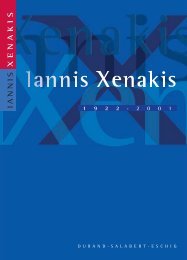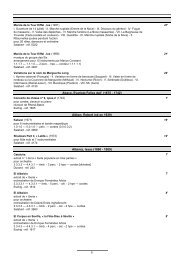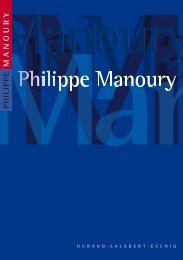messiaen olivier 1 9 0 8 - Durand Salabert Eschig
messiaen olivier 1 9 0 8 - Durand Salabert Eschig
messiaen olivier 1 9 0 8 - Durand Salabert Eschig
You also want an ePaper? Increase the reach of your titles
YUMPU automatically turns print PDFs into web optimized ePapers that Google loves.
Le cycle de mélodies Poèmes pour Mi porte une vive tension entre la nature de sa<br />
poésie et l’ampleur de sa musique. Avec un recul de quatre années, cette poésie<br />
chante la joie profonde du mariage, dont elle semble être, en quelque sorte, le journal<br />
intime : en 1932, Olivier Messiaen avait épousé Claire Delbos, surnommée « Mi » . Les<br />
neufs mélodies qui, en deux livres, constituent Poèmes pour Mi, peignent l’amour et son<br />
accomplissement ; toutefois, malgré une fin resplendissante, elles frappent par leur<br />
alternance de sereine gratitude adressée à Dieu et de visions d’épouvante presque<br />
prémonitoires (après la naissance d’un fils, cette union allait s’achever par le décès<br />
prématuré de Claire Delbos). L’amour conjugal ici décrit est placé sous les influences<br />
croisées du poète Pierre Reverdy, de diverses lectures saintes et de ces paysages des Alpes<br />
qui allaient être chers au compositeur jusqu’à la fin de sa vie.<br />
Au genre de la mélodie, d’ordinaire concis et économe en moyens, Messiaen apporta<br />
ici une considérable densité, tant rythmique que vocale. Dans Poèmes pour Mi, il propose<br />
toutes les facettes de ses découvertes rythmiques : rythmes non-rétrogradables, mètres<br />
grecs, canons rythmiques ou mètres de l’Inde ancienne. Quant à l’écriture vocale, elle<br />
n’aurait pu atteindre cette ampleur si le compositeur n’avait rencontré le « grand soprano<br />
dramatique », Marcelle Bunlet, « qui avait une voix très malléable et un registre très<br />
étendu, et qui chantait facilement Isolde, Kundry et Brünnhilde. Je lui ai donc destiné mes<br />
cycles de mélodies qui sont très longs, très fatigants pour le souffle, et qui exigent une<br />
très grande étendue vocale. »<br />
En 1937, Messiaen allait orchestrer ces Poèmes pour Mi, devenu un trésor à deux<br />
faces : le noir et blanc du piano et le « chatoiement sonore » de l’orchestre.<br />
In the song cycle Poèmes pour Mi, there is a lively tension between the nature of the<br />
poetry and the opulence of the music. Written four years after Messiaen’s marriage, in<br />
1932, to Claire Delbos (nicknamed ‘Mi’), the poetry celebrates the profound joy of<br />
marriage, and seems to be an intimate journal of that marriage. The nine songs in two<br />
books that constitute Poèmes pour Mi depict love and its fulfillment; however, in spite<br />
of its resplendent ending, the cycle is striking for the way it alternates serene gratitude,<br />
addressed to God, with almost premonitory visions of terror (after the birth of a son, this<br />
union would be brought to an end by the premature death of Claire Delbos). Messiaen’s<br />
depiction of conjugal love is influenced in turn by the poet Pierre Reverdy, by various<br />
sacred texts, and by the Alpine landscapes that the composer treasured until the end of<br />
his life.<br />
In this work, Messiaen brought considerable rhythmic and vocal complexity to the<br />
genre of the French art song, which is generally known for its economy of means. In<br />
Poèmes pour Mi he uses every facet of his rhythmic discoveries: non-retrogradable<br />
rhythms, Greek meters, rhythmic canons, and ancient Indian meters. As for the vocal<br />
writing, it would not have been so opulent if the composer had not met the “great<br />
dramatic soprano” Marcelle Bunlet, “who had a very versatile voice and a very wide<br />
range, and was at ease singing Isolde, Kundry and Brünnhilde. Thus, it is for her that I<br />
wrote my song cycles that are very long, very tiring for the breath, and require a very<br />
wide vocal range.”<br />
In 1937 Messiaen was to orchestrate ‘Poèmes pour Mi’, making the cycle into a<br />
double-sided treasure: the black and white of the piano, and the “shimmering sonority”<br />
of the orchestra.<br />
35

















